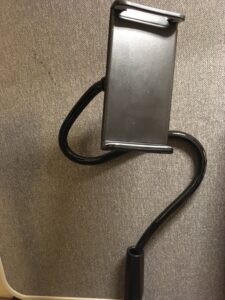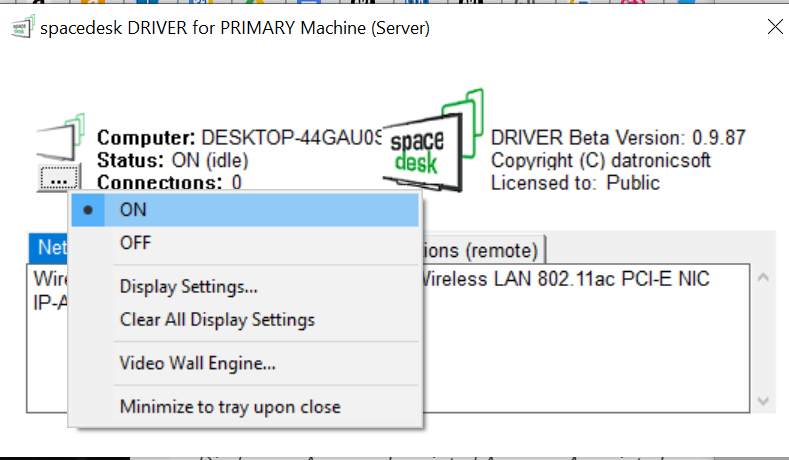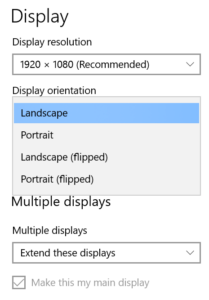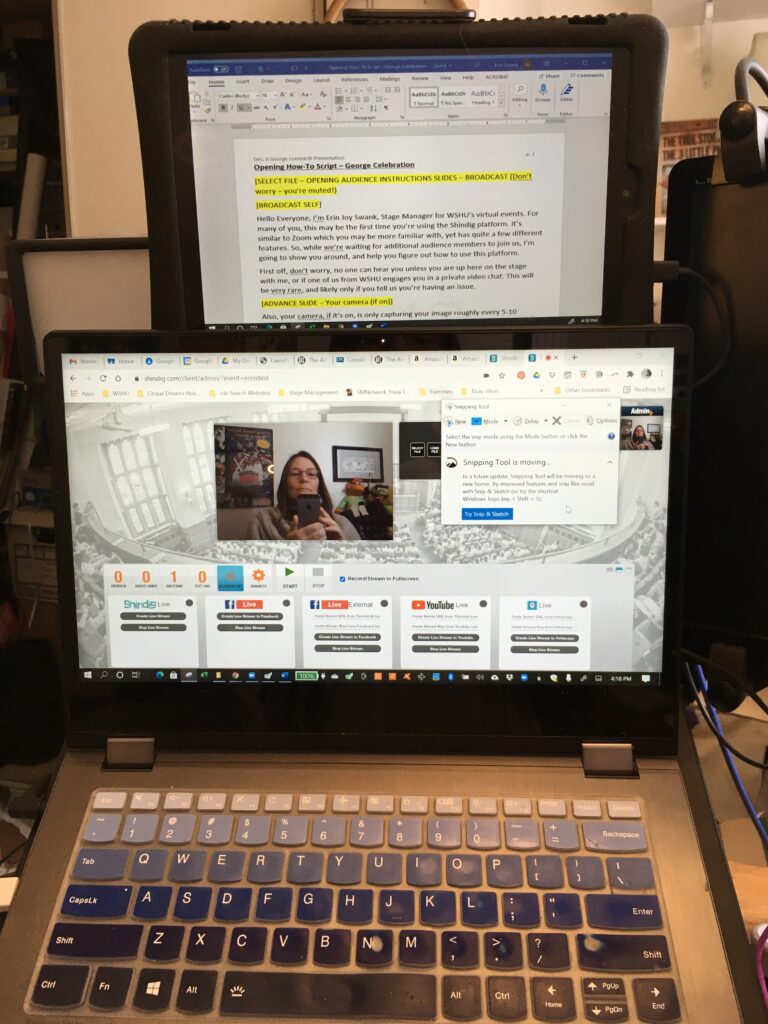Over this past year of the pandemic, I’ve slowly built up the equipment I use for virtual events. First off – if anything is required for you to do your job, and you don’t have it, see if the company you’re working for can pay for it. One of my jobs bought me an Uninterruptible Power Supply after a scare when I lost power – the computer kept running on battery at the time, but my modem went down. I now have my router running through this UPS, and can run over to it to plug in if needed once the battery runs down some. (It will use up the reserve power much quicker than just the router, so the plan is to not plug in the laptop immediately…and I’ll likely make it to the end of any virtual gig.)
Okay, back to the new dual monitor setup…
Last October, during a sale, I purchased a Fire HD 10 Tablet (okay, technically, mine is the kind without ads, and I can’t find a link to it right now). I’d been trying to figure out how to best use it for these virtual gigs. It took me this long, but I finally came up with a use for it that is truly helpful, besides scrolling through social media. I can use my WiFi to make the tablet act like a second monitor.
I found a free app called spacedesk, which has pretty good reviews. I downloaded the app first on my laptop, then on the tablet. See the user manual for the initial setup, as well as do an internet search for your specific tablet’s troubleshooting issues. I will say, it took me a bit to realize that in the tablet, I need to go to the Settings/Display section and turn OFF auto-rotate before bringing up the spacedesk app.
Once it is all set up, whenever I want to utilize it, I click first on the spacedesk app in my laptop’s tray icon.
This brings up the app, where I can click on the three dots next to Connections and switch it to ON. In the same area you’ll find Display Settings.
Turn on your tablet, and bring up the spacedesk app there too. Click the “Connection” link on the tablet to get the two to talk to each other.
You’ll also want to make sure your computer display settings are set to multiple monitors, and that they are set to extend. If your orientation is wrong, you can choose between landscape and portrait, and whether they need to be flipped.
At first, only your computer’s desktop/background image will show up, along with the tray icon at the bottom (or, alternately, as a complete duplicate image of your laptop, if you don’t have it set to extend). Like a normal dual monitor system, if you drag a window to the right, off screen, it will show up in the second monitor. In my situation, I’m actually putting the Fire above my computer, so it takes a bit of practice to get used to it. On the first day, I got very used to playing with it while watching an informative webinar. I took “Snip & Sketch” images from the webinar, then moved my cursor to the Fire where I had a document of notes where I could paste in the images. I got very used to moving left and right to make it really go up and down. It takes some practice, but after a bit I know I’ll be able to use this more fluidly for a virtual performance. When I want to get really nerdy/fancy, I pull up the same Google doc on my second computer. It’s easier to type on that one, since the laptop is up in the air a bit.
FYI – don’t forget to turn OFF snapdesk when you no longer need the dual setup!
UPDATE – I did have a moment today where I heard that familiar sound (in my mind it’s descending pitches of “bee-dee-BOOP”) of when you unplug a USB drive or something doesn’t work, and suddenly the 2nd monitor was frozen. I’m still not completely sure what stopped the connection. Was it a glitch in my WiFi, whereas the laptop is on a hard wire? Anyway, in the meantime, it just meant that the “extended” windows went back into the laptop and could be clicked on, while I figured out how to reset the connection. Everything was still there, I was just back to having it all on one device for the moment. It’s the first it’s happened and I’ve been using it quite a bit already. I kinda like this setup.
Update: Other Options
In response to my sharing this post on Facebook, my friend Victoria Frank commented, “On a Mac, you can use the Duet app or, if your gear is pretty new, you can use the built in SideCar functionality and pair your iPad to be an extra monitor! I use it all the time!”
Please do let me know what other options you’ve discovered as well.
My New Tablet Holder
Within a day of figuring out this app, I realized I wanted to be able to mount it near my laptop. I’ll go into later how I have my laptop rigged up on my desk right now, but I found this Cellphone & Tablet 2 in 1 Stand Holder Clip with Grip Flexible Long Arm Gooseneck Bracket Mount Clamp for a reasonable price on Amazon. I knew my Fire was a bit heavy for something like this, so looked around for reviews of ones that seemed strong enough. It wasn’t the quickest setup, but once I got it wrangled around, I really like it. It is not really a “clip” to mount to the table (or in my case it’s clamped on an arm of something else)…there is nothing to squeeze to open it. Instead, it has a cylinder at the bottom that you unscrew to open up the part similar to a clamp. As was recommended, I also curved it into an S shape in order to give it the most stability, and worked with the ball joint and the weight of it to also make it the most stable. I chose this model in particular because of the length of the gooseneck and the ability to curve it for stability.

I now have my tablet positioned above my laptop. My thought is that if I have to read off a script and be live on camera, it’s the closest to being next to the web camera. I can also have my 2nd computer and its large monitor nearby on the right, which I’ll discuss in a different blog post.
In the above image, I have the script I read of audience instructions when working in Shindig on the tablet, with the Shindig admin panel below. My web camera is right next to that little white light at the top of the laptop. You can barely see the edges of the clamp around the tablet, which I’m using as a dual monitor. Shindig has a feature to easily copy/paste audience questions to format to panelists and other admins. My plan is to put our chats in this second monitor so I can see all of Shindig on the laptop screen, but easily copy/paste into the second monitor.
The clamp allows me to keep the tablet plugged in to a power source the entire time, too, separate from the laptop’s power supply.
*Purchasing from Amazon
You can make your own decisions as to whether to purchase from Amazon, or find similar equipment elsewhere. I’m trying out this Amazon Associate thing because, well, there’s not a lot of money coming in right now, so why not try? That said, there are a couple other factors for me in getting things through Amazon. For one thing, the credit card that I have had for more than a decade now lets me use its reward points at Amazon. I have been able to obtain several pieces of equipment for this virtual world either free or discounted because of this program, and for that I am grateful over the last year where stage management work is few and far between. Additionally, I make sure I am logged in through the Amazon Smile program before I purchase anything (you can add to your cart before that). My account is linked to the Behind the Scenes Charity, which provides financial assistance for those who are seriously ill or injured (including those in the hospital with COVID) who have earned their living for at least five years in the entertainment technology industry. A percentage of my purchases goes to their fund, even if I completely use my rewards points. Win-win!




1 thought on “Using a Tablet as a Second Monitor”
Comments are closed.